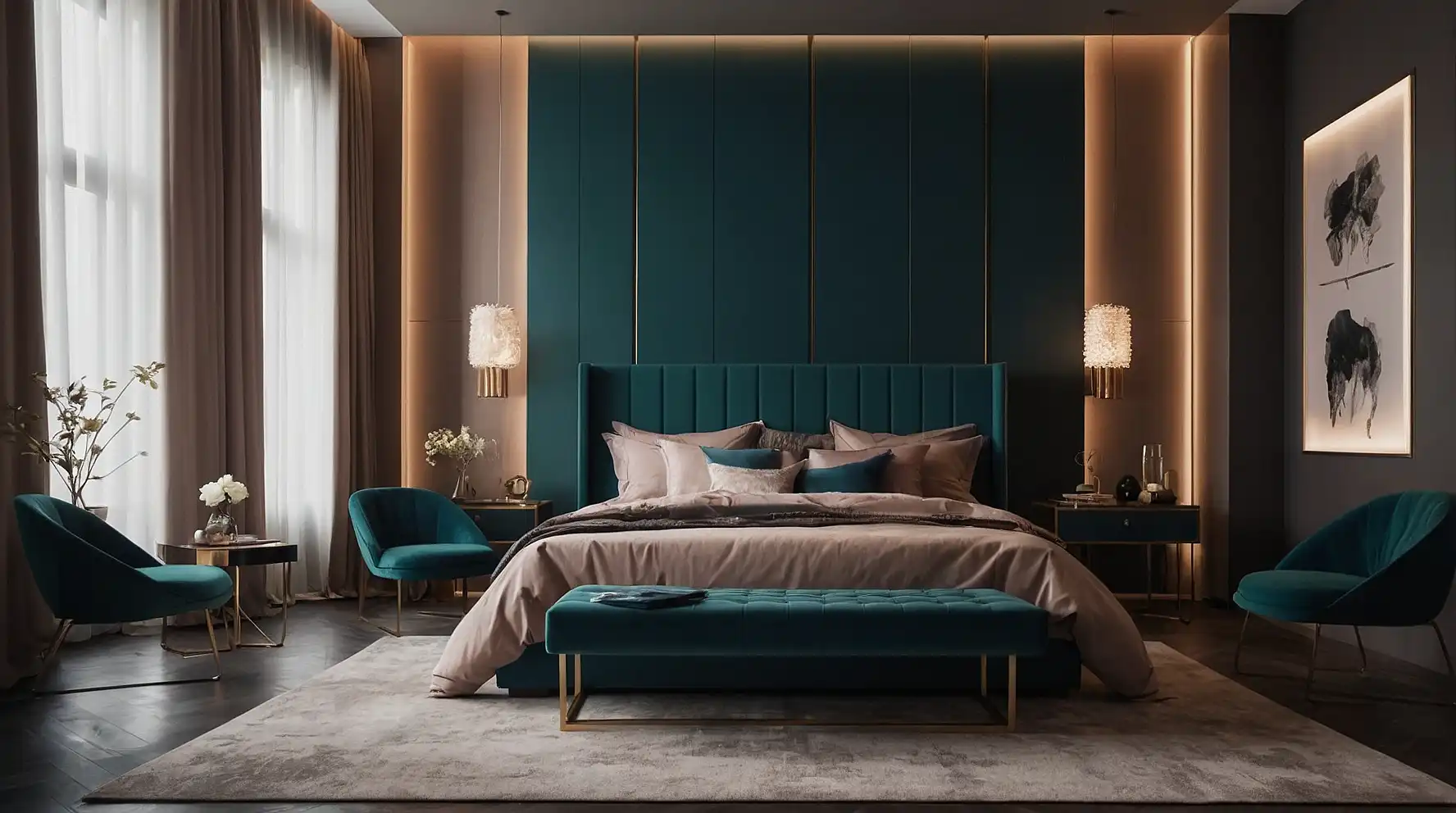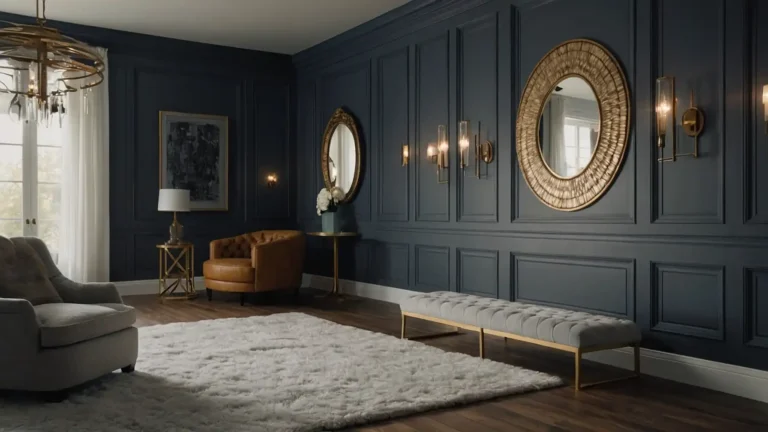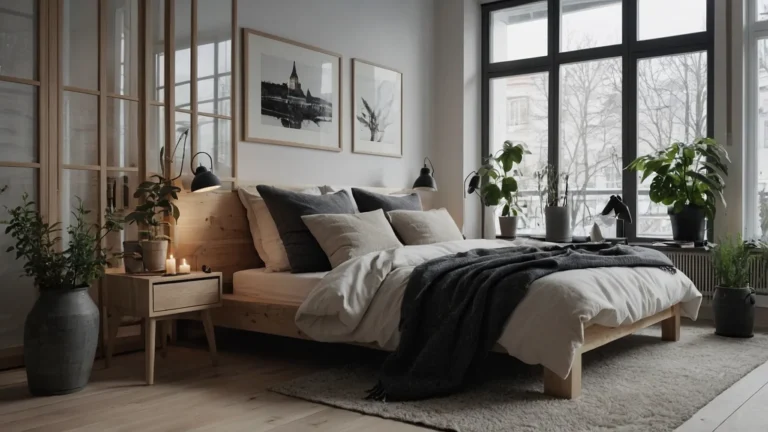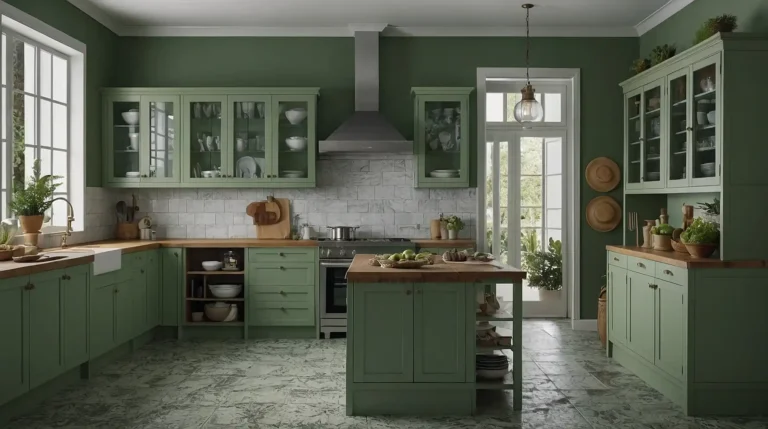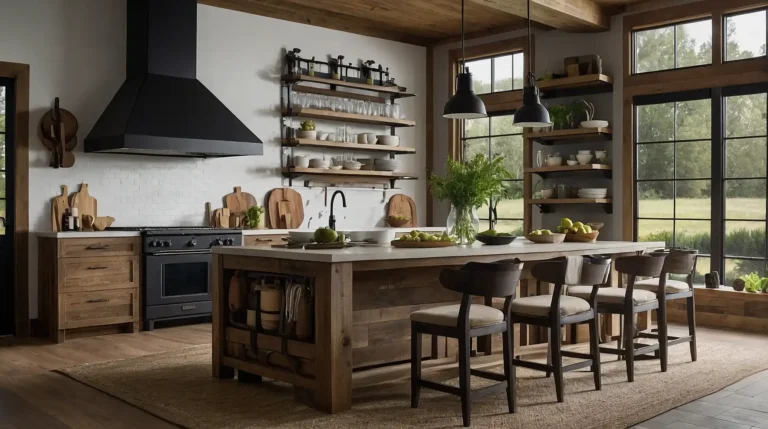27 Beautiful Bedroom Colors to Transform Your Sleep Sanctuary
Your bedroom color choice affects more than just aesthetics—it influences your mood, sleep quality, and overall well-being.
The right hue can transform your space from merely functional to truly restorative.
With countless options available, selecting the perfect bedroom color can feel overwhelming.
Each shade creates a different atmosphere, from calming and serene to energizing and inspiring.
Discover these 27 beautiful bedroom colors that design experts recommend for creating your ideal sleep sanctuary.
Whether you prefer soft neutrals or bold statements, you’ll find the perfect palette to match your personal style.
1: Tranquil Blue

Create a peaceful retreat with a soft, muted blue that mimics clear skies.
This versatile color lowers blood pressure and heart rate, naturally promoting relaxation and sleep.
Pair with crisp white trim and natural wood accents for a timeless coastal feel. For depth, incorporate varying blue tones through textiles and accessories.
This color works beautifully in bedrooms with good natural light, as it reflects daylight while remaining soothing in evening hours.
2: Sage Green

Bring the calming essence of nature indoors with a muted sage green.
This earthy tone creates a grounding effect that helps transition your mind from daytime activity to evening rest.
Complement with cream, taupe, or warm wood elements to enhance its organic appeal.
The versatility of sage allows it to function as either a neutral backdrop or a gentle color statement.
This shade adapts beautifully to changing light, appearing fresher in morning light and cozier in the evening.
3: Soft Lavender

Embrace subtle color with a pale lavender that promotes tranquility without overwhelming your space.
This delicate purple hue contains both warm and cool undertones, making it surprisingly versatile.
Balance with gray or beige accents to prevent the room from feeling too sweet. Lavender particularly complements brass or gold hardware and lighting fixtures.
This unexpected neutral works wonderfully in both traditional and contemporary bedroom designs while promoting restful sleep.
4: Warm Terracotta

Create an enveloping sanctuary with rich terracotta that adds warmth and dimension.
This earthy tone creates instant coziness while adding sophisticated color to your bedroom retreat.
Pair with cream, ivory, or white bedding to brighten and balance the depth.
Natural fibers and textiles enhance terracotta’s organic appeal and prevent it from feeling heavy.
This color transforms dramatically throughout the day, glowing warmly at sunset and creating a protective cocoon-like feeling at night.
5: Classic Gray

Establish timeless sophistication with a mid-tone gray that provides the perfect neutral backdrop.
This chameleon-like color adapts to your existing furnishings and design preferences.
Choose a gray with undertones that complement your flooring and furniture finishes.
Add textural elements like velvet, linen, or knit throws to prevent the space from feeling flat.
This versatile foundation allows you to easily refresh your bedroom with seasonal accent colors through accessories and textiles.
6: Blush Pink

Create subtle warmth with blush pink, which flatters all skin tones and creates a soft, welcoming atmosphere.
This grown-up pink reads almost as a neutral when used appropriately.
Balance with charcoal gray or navy blue accents to add sophistication and prevent a juvenile appearance.
Incorporate metallic elements like brass or gold to enhance blush’s inherent warmth.
This color particularly shines in rooms with northern or eastern exposure, counteracting cooler natural light.
7: Crisp White

Maximize light and create an airy, spacious feeling with a clean white palette. This timeless choice provides flexibility to change accent colors as your taste evolves.
Choose whites with subtle undertones—creamy for warmth or blue-whites for a crisper feel.
Add texture through bedding, window treatments, and rugs to prevent the space from feeling sterile.
This color works particularly well in smaller bedrooms or those with limited natural light, creating an illusion of expanded space.
8: Charcoal Gray

Create dramatic sophistication with deep charcoal walls that cocoon your sleep space.
This bold neutral provides depth while remaining more versatile than true black.
Balance with lighter bedding and furnishings to prevent the room from feeling too dark.
Add mirrors and metallic accents to reflect available light throughout the space.
This color creates a perfect backdrop for artwork and statement lighting, allowing decorative elements to truly shine.
9: Dusty Blue

Introduce subtle color with a muted, grayish blue that promotes tranquility.
This sophisticated shade bridges the gap between traditional blues and modern neutrals.
Pair with warm woods and natural textiles to balance the cool undertones. Layer in cream or ivory bedding to soften the overall effect.
This versatile color adapts to both traditional and contemporary design schemes while maintaining a restful atmosphere.
10: Warm Ivory

Create timeless elegance with a warm ivory that softens your bedroom’s architectural features.
This flexible neutral provides more warmth than stark white without introducing obvious color.
Layer in textural elements through bedding, window treatments, and rugs for depth.
Incorporate natural materials like wood, rattan, or stone to enhance ivory’s organic quality.
This color choice allows your furnishings and personal items to become the focal points while providing a cohesive backdrop.
11: Emerald Green

Make a bold statement with rich emerald green that creates a luxurious, enveloping bedroom retreat.
This jewel tone adds instant sophistication and unexpected depth.
Balance with plenty of white or cream to prevent the color from overwhelming the space. Incorporate brass or gold accents to enhance emerald’s inherent richness.
This dramatic choice creates a memorable, distinctive bedroom that still promotes restfulness through its connection to nature.
12: Pale Gray-Blue

Create a versatile backdrop with a light gray-blue that shifts subtly throughout the day.
This chameleon-like color adapts to changing light conditions while maintaining a soothing presence.
Pair with white trim and natural wood elements for a fresh, timeless effect. The balanced undertones work well with most existing furniture finishes.
This color bridges traditional and contemporary styles, making it perfect for transitional design approaches that blend elements of both.
13: Soft Black

Embrace dramatic sophistication with a soft black that creates a cocooning effect.
This bold choice adds architectural interest and unexpected depth to your bedroom retreat.
Balance with plenty of white in bedding, artwork, and accessories to create necessary contrast.
Add textural elements like velvet, linen, or wool to soften the visual weight.
This statement color works particularly well in bedrooms with good natural light or taller ceilings that can handle the visual weight.
14: Buttery Yellow

Introduce subtle warmth with a pale, buttery yellow that mimics gentle morning sunlight.
This cheerful yet sophisticated color creates a naturally uplifting atmosphere.
Choose a muted shade with beige or cream undertones rather than bright primary yellow.
Balance with white, gray, or navy accents to add sophistication and prevent overwhelming cheerfulness.
This color particularly benefits bedrooms with northern exposure, counteracting cooler natural light with its inherent warmth.
15: Taupe

Create subtle sophistication with taupe, the perfect balance between gray and beige.
This chameleon-like neutral adapts to both warm and cool accent colors with equal success.
Layer different textures to prevent the color from appearing flat or uninspired. Incorporate white elements to provide contrast and visual breaks.
This versatile foundation allows your artwork and textiles to shine while providing a cohesive, sophisticated backdrop for any design style.
16: Navy Blue

Establish timeless elegance with deep navy blue that creates a cocooning effect.
This sophisticated color adds architectural interest while remaining more versatile than black.
Balance with crisp white bedding and accents to create necessary contrast.
Add mirrors and metallic elements to reflect light and prevent the space from feeling too dark.
This color works beautifully in bedrooms of all sizes, contrary to the myth that dark colors only suit large spaces.
17: Pale Mint
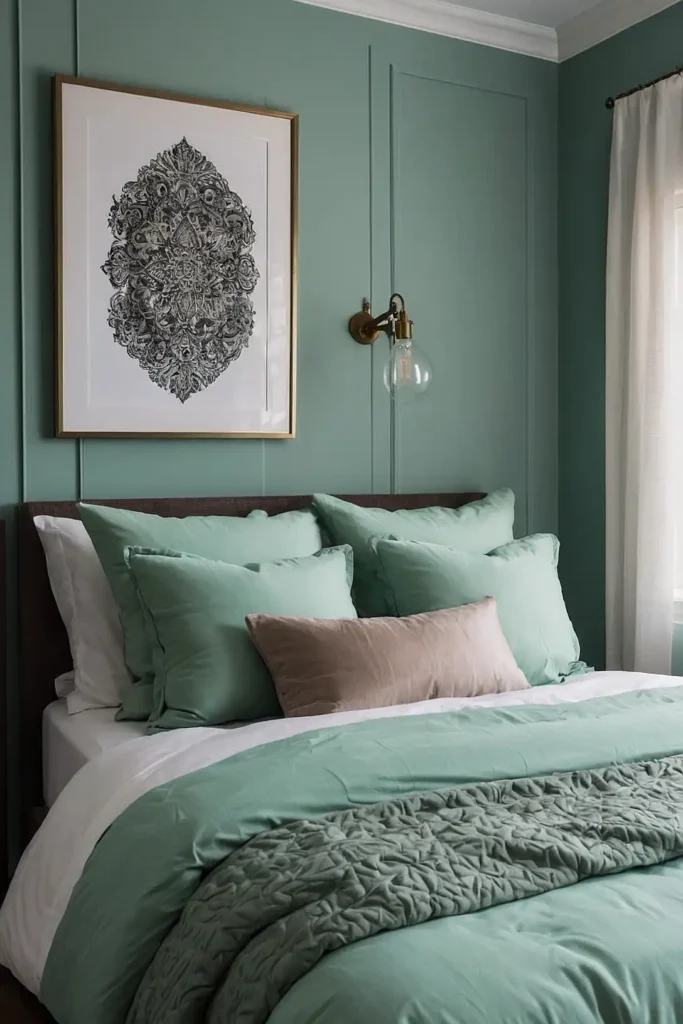
Create a fresh, rejuvenating atmosphere with a soft mint green that feels both vintage and contemporary.
This gentle color promotes relaxation while adding subtle personality.
Pair with bright white trim and natural wood elements for balance. Add gray or taupe accents to ground the lightness and prevent a juvenile appearance.
This color particularly shines in bedrooms with southern exposure, as it helps counteract intense, warm natural light.
18: Soft Coral

Introduce unexpected warmth with a muted coral that flatters all skin tones. This sophisticated version of pink-orange creates an instantly welcoming atmosphere.
Balance with cream or gray elements to prevent the color from feeling overwhelming.
Incorporate natural materials like wood, rattan, or jute to ground the brightness.
This color bridges seasons beautifully, feeling fresh in summer and warming in winter months.
19: Greige

Create versatile elegance with greige, the perfect balance between gray and beige.
This chameleon-like neutral adapts to changing light and seasonal decor with equal success.
Incorporate varying textures to prevent the color from appearing flat or uninspired.
Layer in natural elements like wood, stone, or plants to enhance its organic quality.
This sophisticated foundation allows for endless accent color possibilities while maintaining a cohesive, designer-approved backdrop.
20: Powder Blue

Embrace subtle color with a soft powder blue that promotes tranquility and restful sleep.
This traditional bedroom choice remains popular for its timeless, soothing qualities.
Pair with white trim and natural wood elements for a fresh, classic effect. Add deeper blue accents through textiles to create depth and visual interest.
This color particularly benefits bedrooms with warm, southern or western exposure by counteracting intense afternoon light.
21: Rich Chocolate

Create a cozy sanctuary with deep chocolate brown that adds warmth and sophistication.
This underutilized neutral provides drama without the starkness of black.
Balance with plenty of white, cream, or ivory to prevent the room from feeling too dark. Incorporate textural elements like linen, velvet, or wool to add dimension.
This color creates an excellent backdrop for artwork and statement furniture, allowing other elements to truly shine.
22: Pale Gray

Establish contemporary elegance with a light gray that provides more interest than white while maintaining neutrality.
This versatile choice adapts to your existing furnishings and preferences.
Choose a gray with undertones that complement your flooring and furniture finishes.
Add colorful accents through art, textiles, and accessories for personalization.
This flexible foundation allows you to easily refresh your bedroom as trends and preferences change throughout the years.
23: Dusty Olive

Bring natural sophistication with a muted olive green that bridges the gap between neutral and color.
This earth tone connects your interior to the natural world outside.
Complement with cream, taupe, or warm wood elements to enhance its organic appeal. Add black or charcoal accents for definition and contemporary edge.
This unexpected choice works beautifully in both modern farmhouse and contemporary design schemes while promoting restful sleep.
24: Pale Peach

Create subtle warmth with a soft peach that flatters all skin tones and adds a welcoming glow.
This sophisticated alternative to beige offers similar versatility with more personality.
Balance with gray or navy accents to prevent the color from feeling too sweet. Incorporate natural materials like wood, leather, or rattan to ground the softness.
This color particularly benefits bedrooms with northern exposure, counteracting cooler natural light with its inherent warmth.
25: Slate Blue

Establish sophisticated tranquility with a deep slate blue that bridges gray and navy.
This complex color changes subtly throughout the day, creating visual interest.
Pair with bright white trim and bedding to create necessary contrast.
Add warm wood elements to balance the cool undertones and prevent the space from feeling cold.
This color works beautifully in bedrooms of all sizes, creating a cocooning effect that promotes restful sleep.
26: Creamy Mushroom

Embrace organic neutrality with a soft mushroom tone that provides warmth without obvious color.
This sophisticated alternative to beige offers depth and character.
Incorporate varying textures to enhance the natural quality and prevent flatness. Pair with white trim and lighter bedding to create necessary contrast.
This versatile foundation allows artwork and textiles to shine while providing a cohesive, elegant backdrop for any design style.
27: Midnight Teal

Create dramatic sophistication with deep teal that adds unexpected depth and personality. This jewel tone feels both classic and contemporary simultaneously.
Balance with white or cream elements to prevent the color from overwhelming the space.
Add brass or gold accents to enhance teal’s inherent richness and complexity.
This statement color transforms your bedroom into a memorable retreat while still promoting restfulness through its blue undertones.
Conclusion
Choose colors that resonate with your personal style and desired atmosphere.
Test samples in your actual space before committing, as lighting dramatically affects how colors appear.
Remember that your bedroom should reflect both your aesthetic preferences and support quality sleep.

